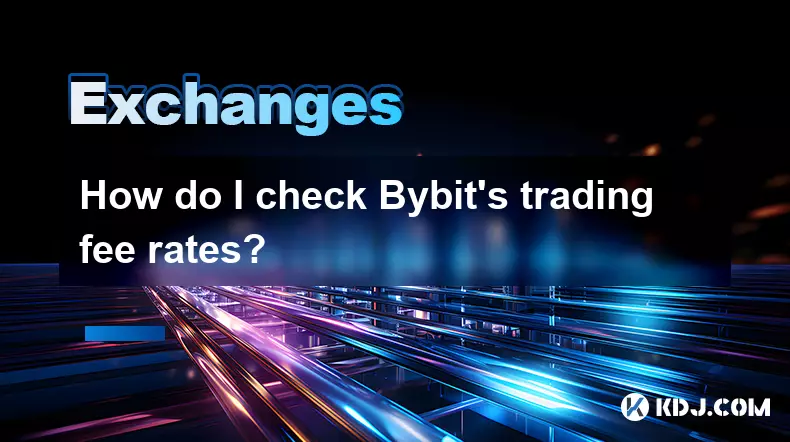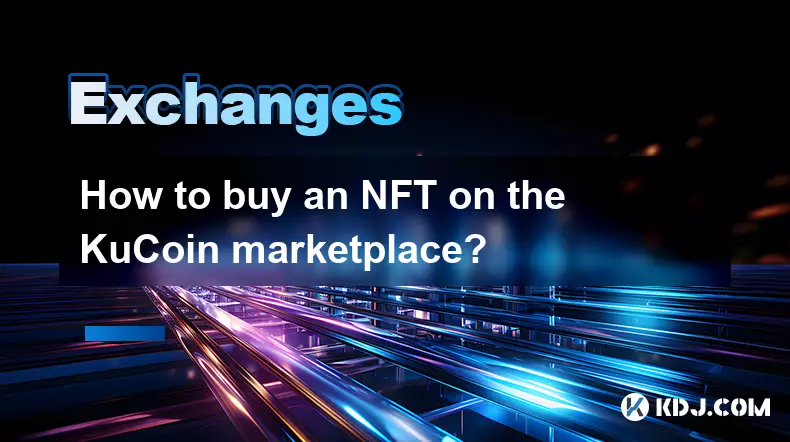-
 bitcoin
bitcoin $120167.907534 USD
1.27% -
 ethereum
ethereum $4468.611945 USD
2.53% -
 xrp
xrp $3.013607 USD
1.80% -
 tether
tether $1.000549 USD
-0.01% -
 bnb
bnb $1092.592149 USD
6.28% -
 solana
solana $231.391244 USD
4.59% -
 usd-coin
usd-coin $0.999699 USD
-0.04% -
 dogecoin
dogecoin $0.259020 USD
4.30% -
 tron
tron $0.342747 USD
0.34% -
 cardano
cardano $0.860977 USD
1.07% -
 hyperliquid
hyperliquid $50.155412 USD
5.34% -
 chainlink
chainlink $22.637678 USD
0.46% -
 ethena-usde
ethena-usde $1.000528 USD
-0.07% -
 avalanche
avalanche $30.613779 USD
-0.07% -
 stellar
stellar $0.403905 USD
0.94%
How do I check Bybit's trading fee rates?
Bybit uses a tiered maker-taker fee system, with standard rates at 0.01% (maker) and 0.06% (taker), adjustable based on trading volume or BIT token holdings.
Sep 30, 2025 at 07:36 am

Understanding Bybit's Fee Structure
1. Bybit operates on a tiered fee system that varies depending on whether a user is a maker or a taker in the trading process. Makers provide liquidity by placing limit orders that don’t immediately execute, while takers remove liquidity by fulfilling existing orders. Each role carries different fee rates.
2. The standard taker fee on Bybit is 0.06%, while the maker fee is typically set at 0.01%. These base rates apply to users who haven’t qualified for any discounts through holding Bybit’s native token, BIT, or achieving high trading volumes.
3. Users can reduce their fees by increasing their 30-day trading volume or by holding a certain amount of BIT tokens in their account. The more volume accumulated or the higher the BIT balance, the lower the applicable fees become across both spot and derivatives markets.
4. Fee discounts are automatically applied based on the user’s current tier, which is determined at the beginning of each calendar month. There is no need to manually activate reduced rates as long as the qualifying conditions are met.
5. Institutional traders and high-volume participants may qualify for custom fee schedules. These arrangements are usually negotiated directly with Bybit’s business development team and offer more favorable terms than public tiers.
Accessing Fee Information on Bybit’s Website
1. Navigate to the official Bybit website and scroll to the bottom of the homepage. Under the “Support” section, click on “Fees” to access the dedicated page outlining all transaction costs.
2. On the Fees page, users will find detailed tables breaking down costs for spot trading, perpetual contracts, and inverse futures. Each table includes maker and taker rates across different user tiers.
3. The fee schedule also specifies funding rates for perpetual swaps, deposit and withdrawal charges for various cryptocurrencies, and conversion fees when using services like Token Swap.
4. A dropdown menu allows visitors to select their account type—individual or institutional—and view corresponding rates. This ensures accuracy for users operating under specific regulatory or volume-based classifications.
5. Regular updates are posted at the top of the page, indicating any recent changes to the fee structure along with effective dates. Subscribing to Bybit’s announcement channel ensures timely awareness of adjustments.
Checking Personalized Rates in Your Account
1. Log into your Bybit account and proceed to the “Assets” section located in the main navigation bar. Here, you can see your current 30-day trading volume and VIP level.
2. Click on the “VIP” tab to view your personalized fee rate based on either trading volume or BIT holdings. The interface displays both your current maker and taker fees alongside the thresholds for upgrading to the next tier.
3. Within the trading interface, hover over the fee indicator near the order placement panel. A tooltip will appear showing the exact percentage being charged per trade based on your status.
4. Users engaged in futures trading can check their funding rate history under the “Derivatives” section. This helps anticipate recurring costs associated with open positions held beyond the funding interval.
Your real-time fee rate is always visible in the trade execution panel before confirming any order, ensuring full transparency prior to entry.Frequently Asked Questions
What is the difference between maker and taker fees on Bybit?Maker fees apply when you place a limit order that adds liquidity to the order book. Taker fees are charged when you place an order that instantly matches with an existing one, removing liquidity. Bybit generally offers lower maker fees to incentivize market-making behavior.
Can holding BIT tokens reduce my trading fees?Yes. Holding a specified amount of Bybit’s native token, BIT, qualifies users for discounted fee tiers. The required balance is locked in the account and must be maintained to retain the benefits. Higher balances correspond to greater reductions in both maker and taker fees.
Are there separate fee structures for spot and derivatives trading?Bybit maintains distinct fee schedules for spot and derivatives markets. While both use the maker-taker model, the exact percentages and VIP tier requirements may differ. Derivatives trading often includes additional costs such as funding rates for perpetual contracts.
How often are fee tiers updated on Bybit?User fee tiers are recalculated at the start of each month based on the previous 30 days of trading activity. Changes take effect automatically without requiring manual intervention. If your volume or BIT holdings shift significantly mid-month, the update will reflect in the following cycle.
Disclaimer:info@kdj.com
The information provided is not trading advice. kdj.com does not assume any responsibility for any investments made based on the information provided in this article. Cryptocurrencies are highly volatile and it is highly recommended that you invest with caution after thorough research!
If you believe that the content used on this website infringes your copyright, please contact us immediately (info@kdj.com) and we will delete it promptly.
- BlockDAG, DOGE, HYPE Sponsorship: Crypto Trends Shaping 2025
- 2025-10-01 00:25:13
- Deutsche Börse and Circle: A StableCoin Adoption Powerhouse in Europe
- 2025-10-01 00:25:13
- BlockDAG's Presale Buzz: Is It the Crypto to Watch in October 2025?
- 2025-10-01 00:30:13
- Bitcoin, Crypto, and IQ: When Genius Meets Digital Gold?
- 2025-10-01 00:30:13
- Stablecoins, American Innovation, and Wallet Tokens: The Next Frontier
- 2025-10-01 00:35:12
- NBU, Coins, and Crypto in Ukraine: A New Yorker's Take
- 2025-10-01 00:45:14
Related knowledge

How to close my position in KuCoin Futures?
Oct 01,2025 at 07:54pm
Understanding Position Closure in KuCoin FuturesTrading futures on KuCoin requires a clear understanding of how to manage open positions. Closing a po...

How to find the contract address for a token on KuCoin?
Sep 30,2025 at 09:00pm
Finding the Contract Address on KuCoin1. Log into your KuCoin account through the official website or mobile application. Navigate to the 'Markets' se...

How to set up SMS verification on my KuCoin account?
Oct 03,2025 at 12:36am
How to Enable SMS Verification on Your KuCoin AccountSecuring your cryptocurrency exchange account is essential, especially on platforms like KuCoin w...

How to update the KuCoin app to the latest version?
Oct 03,2025 at 02:18am
How to Update the KuCoin App: A Step-by-Step GuideKeeping your KuCoin app updated ensures access to the latest security features, trading tools, and u...

How to buy an NFT on the KuCoin marketplace?
Oct 02,2025 at 10:19pm
Accessing the KuCoin NFT Marketplace1. Log in to your KuCoin account through the official website or mobile application. Ensure that two-factor authen...

How to buy KCS (KuCoin Token)?
Oct 01,2025 at 11:00am
Understanding KCS and Its Role in the KuCoin Ecosystem1. KCS, or KuCoin Token, is the native utility token of the KuCoin exchange, a prominent cryptoc...

How to close my position in KuCoin Futures?
Oct 01,2025 at 07:54pm
Understanding Position Closure in KuCoin FuturesTrading futures on KuCoin requires a clear understanding of how to manage open positions. Closing a po...

How to find the contract address for a token on KuCoin?
Sep 30,2025 at 09:00pm
Finding the Contract Address on KuCoin1. Log into your KuCoin account through the official website or mobile application. Navigate to the 'Markets' se...

How to set up SMS verification on my KuCoin account?
Oct 03,2025 at 12:36am
How to Enable SMS Verification on Your KuCoin AccountSecuring your cryptocurrency exchange account is essential, especially on platforms like KuCoin w...

How to update the KuCoin app to the latest version?
Oct 03,2025 at 02:18am
How to Update the KuCoin App: A Step-by-Step GuideKeeping your KuCoin app updated ensures access to the latest security features, trading tools, and u...

How to buy an NFT on the KuCoin marketplace?
Oct 02,2025 at 10:19pm
Accessing the KuCoin NFT Marketplace1. Log in to your KuCoin account through the official website or mobile application. Ensure that two-factor authen...

How to buy KCS (KuCoin Token)?
Oct 01,2025 at 11:00am
Understanding KCS and Its Role in the KuCoin Ecosystem1. KCS, or KuCoin Token, is the native utility token of the KuCoin exchange, a prominent cryptoc...
See all articles










































































